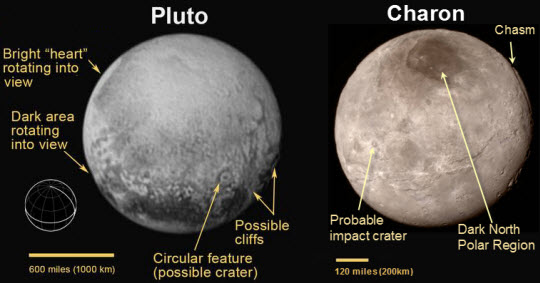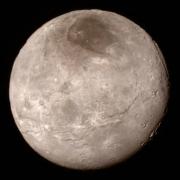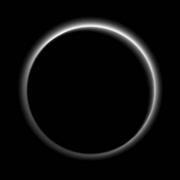Wow, what a success story New Horizons has been so far, rewriting the text books on Pluto, and providing a wealth of insightful data on the likely makeup of other Kuiper belt objects, and the vast majority of data is still to be beamed back.

High-Res Pluto, unveiled to
the Public as New Horizons
made its closest pass of Pluto.
(Click for full-sized image)
It could have been a very different story, as barely a week before New Horizons was scheduled to encounter Pluto, the probe disappeared from NASA’s scanners for around an hour, before coming back online in safe mode. It turns out a flaw in the software caused the system to crash.
High-Res Charon (Click for
full-sized image, which shows
even higher-res detail from
part of the moon.
The probe then had to be targeted through an extremely small area, skimming above the small world just over 11km (7000 miles) up and taking less than 3 minutes to do so. It turns out that at 2,370km (1,473 miles) in diameter, Pluto is slightly larger than previously believed. This makes it indisputedly the largest dwarf planet in the solar system... for now.
In those three minutes the probe would collect as much data as possible, before transmitting back just a few images. This takes time, although New Horizons has a large dish antenna, the probe is so far away the data rate is only 1-2 Kbps. It takes 30-60 minutes to send even one high-resolution image back to Earth.

Some details of note on Pluto and Charon which have surprised project scientists:
Almost no impact craters suggest an evolving surface, mountains, chasms, Nitrogen snow
After a nerve jangling several hour wait, the probe called home and a few images were downloaded. These were a revelation revealing fascinating details, Ice Mountains, ice flows, not many craters; implying that the surface is young and a prominent heart-shaped feature, known - so far unofficially - as Tombaugh Regio, after Clyde Tombaugh, discoverer of Pluto. A close up image of the region near the base of this feature shows a mountain range with peaks jutting as high as 3,500 metres (11,000 feet) above the surface of the icy body, similar in height to the Rocky Mountains on Earth and estimated to be no older than 100 million years.
The surface colouring of Pluto suggests it is a patchwork of different concentrations of frozen methane and nitrogen. These probably sublime into the atmosphere when the planet is closer to the sun and drift back to the ground as snowfall during colder periods.

Left: Solid Methane and Nitrogen in varied abundances, and diluted with Nitrogen
on Pluto's North Pole. Right: Carbon Monoxide as rock in Pluto's "Heart".
Speeding away from Pluto just seven hours after its July 14 closest approach, the New Horizons spacecraft looked back and captured a spectacular image of Pluto’s thin nitrogen atmosphere, extending far out into space, and backlit by the sun, something that scientists hoped to see. Apart from its major moon Charon, which resembles some of the moons of Uranus, New Horizons also observed the smaller members of the Pluto system; Nix, Hydra, Styx and Kerberos. There will be more images of these in the coming months.
The Pluto flyby may well be over, but the mission is set to continue. For a start, the data stored on its onboard recorders will require 16 months to send back, plenty for scientists to scrutinise for years to come, and hopefully in 2018 or 2019 New Horizons will sweep by another kuiper belt object. I have a feeling many exciting discoveries await!
Image Credits: NASA
- Log in to post comments




